 My little collection of roses is starting to “represent”, as my Texas friend would say. I only grow a few. The dwarf climber Jeanne LaJoie is perfectly hardy and willing for me; it does not mind at all being planted with the electric meter. Mini-Jeanne is paired with a voluptuous large flowered climber named Eden-the flower is so beautiful, and the plant is so-so for me, although the foliage seems healthy. This large flowered climber, also known as Pierre de Ronsard, and bred by Meilland in 1987, hasn’t flowered yet-but it is showy.
My little collection of roses is starting to “represent”, as my Texas friend would say. I only grow a few. The dwarf climber Jeanne LaJoie is perfectly hardy and willing for me; it does not mind at all being planted with the electric meter. Mini-Jeanne is paired with a voluptuous large flowered climber named Eden-the flower is so beautiful, and the plant is so-so for me, although the foliage seems healthy. This large flowered climber, also known as Pierre de Ronsard, and bred by Meilland in 1987, hasn’t flowered yet-but it is showy.
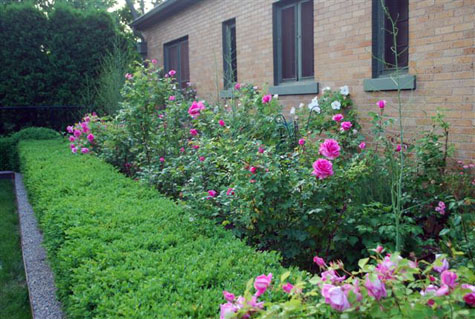
I grow the shrub rose “Carefree Beauty” for good, and sentimental reasons. Griffith Buck bred very hardy, very sturdy shrub roses-this is one of my favorites. I alternate this with his rose “Earthsong”. Some say its better than “Carefree Beauty-I can’t tell. But if your interest is in a low maintenance rose, these qualify. The tall ,English bred shrub rose “Sally Holmes” has gorgeous peach buds, and large single white flowers; I have been growing it for years. One year it died back almost entirely to the ground, but came back.
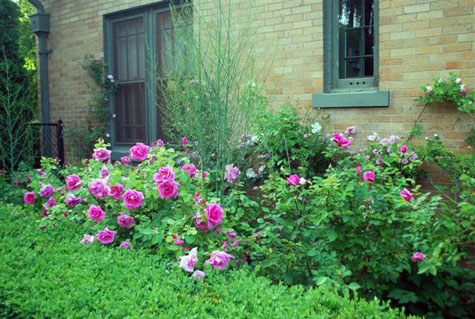
I am not a rosarian by any means. I am not really crazy about rose gardens either. But I do like roses in a mixed border. Roses are such prima donnas-they sulk if there’s anything growing at their feet. So I try to keep my white Japanese anemones, and boltonia out of their hair. I wouldn’t want to do without a few roses.
 You may remember my post from July 21, Renovation Part II, a discussion of what finishing touches were yet to come in this project. If you missed that, I will recap. This beautiful Mediterranean house was in need of a landscape renovation; the new owner is a designer herself, and what she had, she knew would not do.
You may remember my post from July 21, Renovation Part II, a discussion of what finishing touches were yet to come in this project. If you missed that, I will recap. This beautiful Mediterranean house was in need of a landscape renovation; the new owner is a designer herself, and what she had, she knew would not do.
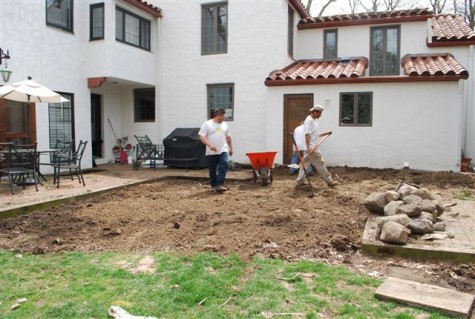 We removed all the plants, and brick, and graded out to the edge of the house; it is too awkward to step down in the middle of a terrace. In other words, we started over.
We removed all the plants, and brick, and graded out to the edge of the house; it is too awkward to step down in the middle of a terrace. In other words, we started over. The new and larger granite and brick terrace stepped down into the lawn; a new stucco wall made for extra seating for guests, and made the suggestion of enclosure.
The new and larger granite and brick terrace stepped down into the lawn; a new stucco wall made for extra seating for guests, and made the suggestion of enclosure.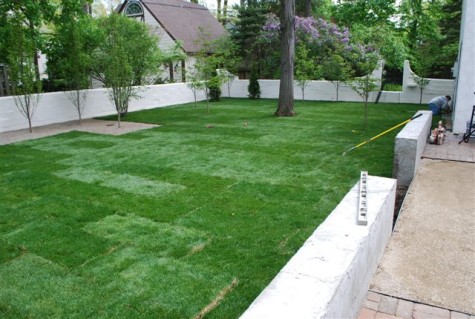 The new rear yard landscape made much of the repaired and repainted stucco wall . A grove of trees in the lawn, a formal arrangement of trees mulched in granite, and grass. Simple and striking.
The new rear yard landscape made much of the repaired and repainted stucco wall . A grove of trees in the lawn, a formal arrangement of trees mulched in granite, and grass. Simple and striking.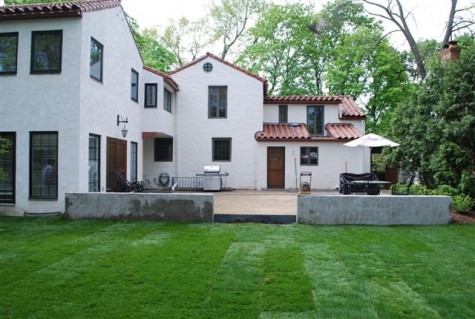 But what else did this landscape need in the way of finishing touches? Inspired by the Spanish flavor of the architecture, I thought some ironwork might be in order.
But what else did this landscape need in the way of finishing touches? Inspired by the Spanish flavor of the architecture, I thought some ironwork might be in order.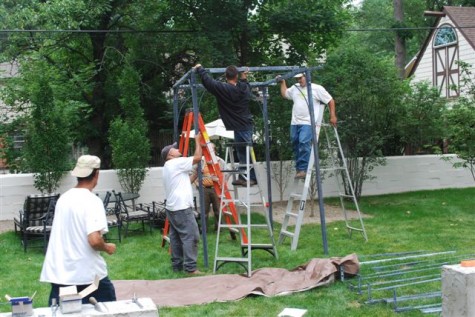
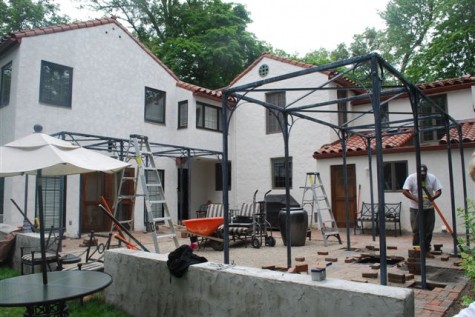 I especially like how the terrace will have two shady cool areas, with a sunny space in between them.
I especially like how the terrace will have two shady cool areas, with a sunny space in between them. 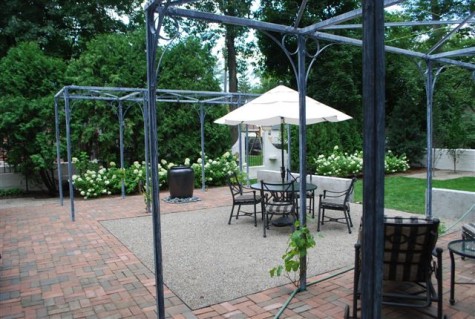 Finishing touches like this can make all the difference in the world; this space looks inviting and comfortable. A place to have dinner, a place to read in the shade, a place to entertain-all good things to plan for.
Finishing touches like this can make all the difference in the world; this space looks inviting and comfortable. A place to have dinner, a place to read in the shade, a place to entertain-all good things to plan for.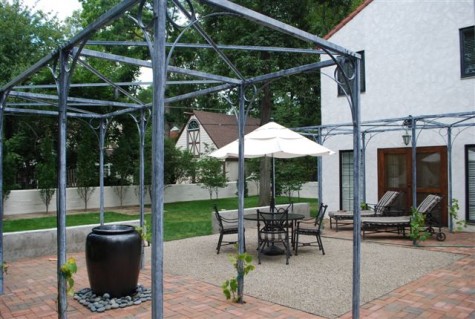 The last touch – a self-contained fountain jar. The reservoir to recirculate the water was installed underground. My client opted for a water jet barely visible. Lighting was unobtrusively installed in the pergola roof, illuminating the fountain at night. I can imagine how it will look and sound once there are grapes overhead.
The last touch – a self-contained fountain jar. The reservoir to recirculate the water was installed underground. My client opted for a water jet barely visible. Lighting was unobtrusively installed in the pergola roof, illuminating the fountain at night. I can imagine how it will look and sound once there are grapes overhead.  A new umbrella is on the way. Maybe there will be holiday lights this winter. Maybe next summer there will be some pots. The finishing touches phase transforms the designed landscape into a landscape for living.
A new umbrella is on the way. Maybe there will be holiday lights this winter. Maybe next summer there will be some pots. The finishing touches phase transforms the designed landscape into a landscape for living.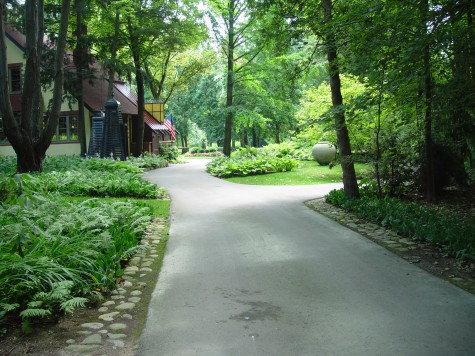 I started to work on this lovely property in 1998. Set in a forest of old trees, the house and landscape had that quiet woodland up-north feeling. Everything I designed for this client I kept in keeping with that feeling; few properties come with an aura as strong as this one did. A case in point; this driveway was laid out with the house in the 1920’s-and was no longer wide enough for modern vehicles. My solution? Edge the drive in small round native to Michigan granite rocks, and let the moss go to work on them. Anyone over the edge with their SUV-no harm. Do no harm-this was my organizing metaphor.
I started to work on this lovely property in 1998. Set in a forest of old trees, the house and landscape had that quiet woodland up-north feeling. Everything I designed for this client I kept in keeping with that feeling; few properties come with an aura as strong as this one did. A case in point; this driveway was laid out with the house in the 1920’s-and was no longer wide enough for modern vehicles. My solution? Edge the drive in small round native to Michigan granite rocks, and let the moss go to work on them. Anyone over the edge with their SUV-no harm. Do no harm-this was my organizing metaphor.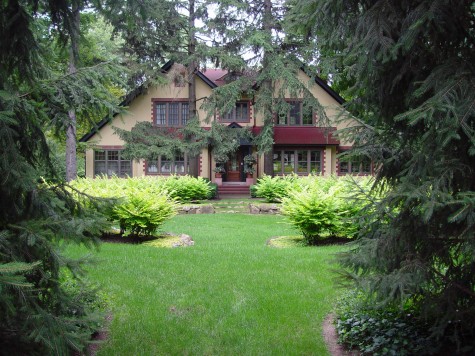 I like formal spaces in front yards, as I like a public presentation that looks good every day. All of us are very busy people-I like a landscape that can wait. But boxwood or taxus hedging seemed alien to the feel of this space. The golden vacary privet-an old plant not much in fashion since its hey day in the 50’s, seemed perfect. The chartreuse color would light up the shade. This very informal material used in a formal way, was a nod to the period and feeling of the vintage house, and its landscape.
I like formal spaces in front yards, as I like a public presentation that looks good every day. All of us are very busy people-I like a landscape that can wait. But boxwood or taxus hedging seemed alien to the feel of this space. The golden vacary privet-an old plant not much in fashion since its hey day in the 50’s, seemed perfect. The chartreuse color would light up the shade. This very informal material used in a formal way, was a nod to the period and feeling of the vintage house, and its landscape.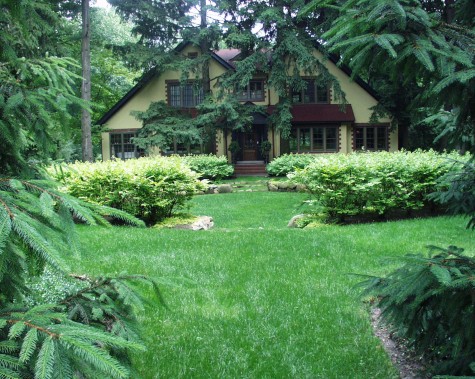 This picture is taken from the road. Old weeping Norway spruce were planted very close and gracefully to the foundation of the house. I repeated this woodland feeling at the road-with a break, a view. A brief view.
This picture is taken from the road. Old weeping Norway spruce were planted very close and gracefully to the foundation of the house. I repeated this woodland feeling at the road-with a break, a view. A brief view.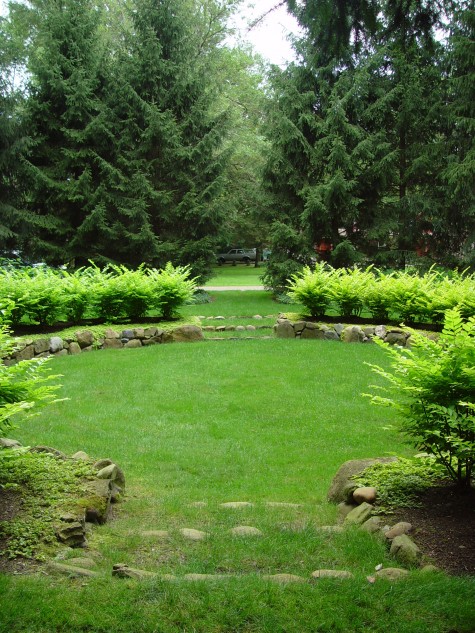 The gold vicary described the shape of a circular sunken garden. What I love the most about the native Michigan woods are how quiet they are; no noise which is technological in origin. No radio, no cars, no jet skis, no boats-just quiet. The sound of birds, wind, footsteps-these sounds are native, natural, and good. Sinking a garden even a little intensifies the quiet. Two simple steps of grass with round rock risers-a casual, northern Michigan detail.
The gold vicary described the shape of a circular sunken garden. What I love the most about the native Michigan woods are how quiet they are; no noise which is technological in origin. No radio, no cars, no jet skis, no boats-just quiet. The sound of birds, wind, footsteps-these sounds are native, natural, and good. Sinking a garden even a little intensifies the quiet. Two simple steps of grass with round rock risers-a casual, northern Michigan detail. 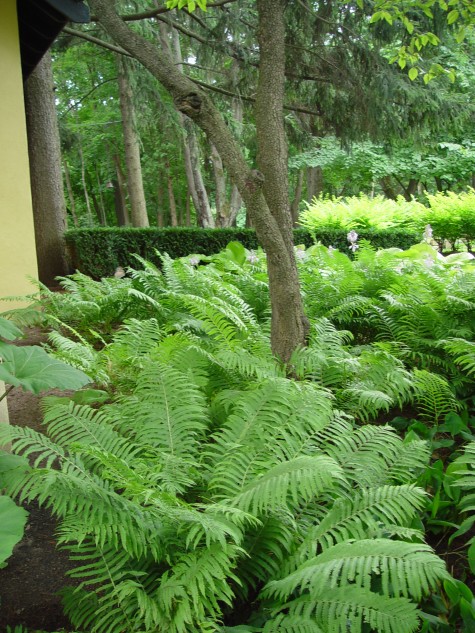 And the ferns? Everywhere. Ostrich ferns as a groundcover-this is a beautiful look. The texture, scale and informality is easy on the eyes, and pleasing. Drifts of ferns really interest me as a designer. They are bold and sculptural in big masses. But they speak directly to the primeval forest; the look of a stand of ferns wrings all the tension out of me.
And the ferns? Everywhere. Ostrich ferns as a groundcover-this is a beautiful look. The texture, scale and informality is easy on the eyes, and pleasing. Drifts of ferns really interest me as a designer. They are bold and sculptural in big masses. But they speak directly to the primeval forest; the look of a stand of ferns wrings all the tension out of me.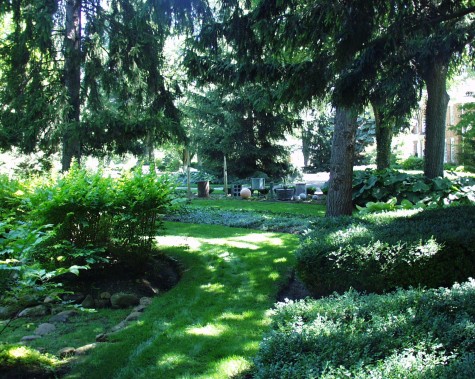 No doubt this was a shady, mossy, quiet, not perfect, natural, woodland landscape. A grouping of funky containers and sculptures, set in groundcover on the far east perimeter, was a nod to the point of view of the client. I love a collection of objects that band together to make a sculpture.
No doubt this was a shady, mossy, quiet, not perfect, natural, woodland landscape. A grouping of funky containers and sculptures, set in groundcover on the far east perimeter, was a nod to the point of view of the client. I love a collection of objects that band together to make a sculpture.  I wrote last Sunday in my weekly opinion post that a ride by this treasured project of mine revealed that the client has ripped most everything out, and installed a new landscape. I felt the shock that anyone feels when they come face to face with something so totally unexpected that blacking out seems an appropriate response. It took me two days to recover, but recover I did.
I wrote last Sunday in my weekly opinion post that a ride by this treasured project of mine revealed that the client has ripped most everything out, and installed a new landscape. I felt the shock that anyone feels when they come face to face with something so totally unexpected that blacking out seems an appropriate response. It took me two days to recover, but recover I did. 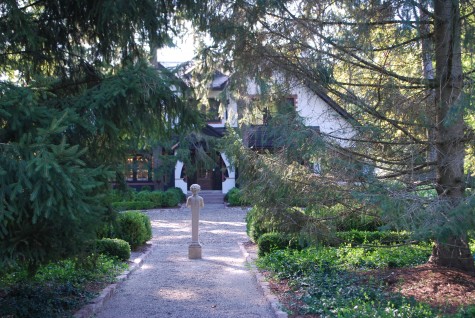 My clients have their own lives, and their own idea of beauty. They hire me-I am not a favorite aunt, or a Mom, or a daughter. Their lives change-I am not privy to most of that. I may be close beyond close for the duration of the project, but I am usually their fifth business. At my age, I know who I am. I appreciate that the lives of my clients are not subject to my review. I furthermore understand that my ownership of a project is while I am making it. What happens after-I am not responsible, nor am I honored. This is as it should be.
My clients have their own lives, and their own idea of beauty. They hire me-I am not a favorite aunt, or a Mom, or a daughter. Their lives change-I am not privy to most of that. I may be close beyond close for the duration of the project, but I am usually their fifth business. At my age, I know who I am. I appreciate that the lives of my clients are not subject to my review. I furthermore understand that my ownership of a project is while I am making it. What happens after-I am not responsible, nor am I honored. This is as it should be. It is not my idea to critique the new landscape-that is not the point of this post. I am not interested in being a critic. I am interested in writing about my life as a designer. It is very tough to see years of work erased-no one cozies up to this. Least of all me. I am interested in history, and continuity. But I do not always get my way.
It is not my idea to critique the new landscape-that is not the point of this post. I am not interested in being a critic. I am interested in writing about my life as a designer. It is very tough to see years of work erased-no one cozies up to this. Least of all me. I am interested in history, and continuity. But I do not always get my way. No matter how this landscape looks now, I am not unhappy about how I approached it. I have no second thoughts. I will sleep sound tonight.
No matter how this landscape looks now, I am not unhappy about how I approached it. I have no second thoughts. I will sleep sound tonight.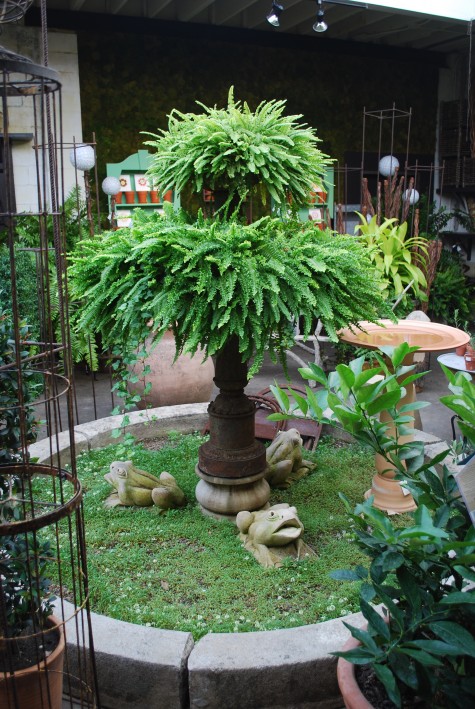 As fond as I am of ferns for shady spots in a perennial garden, there are plenty of tropical species too handsome to pass up. I have a client whose pair of Australian tree ferns flank her front door every summer; they have spent the winter in the greenhouse for the past six years. On a smaller scale, Victorian parlor ferns and Boston ferns prosper in a shady spot outdoors over the summer, and make a decent show in a cool light place indoors over the winter. Every fall we fall heir to a number of plants clients have no place for, but can’t bear to compost. Won’t we take them? Try as I can, I can’t say no to a plant in need of a home. Added to these were a number of ferns Rob grew in pots at home this year. As the dwarf crested ferns we planted 2 years ago in this antique French fountain are clearly very happy, Rob decided a fernery was in order.
As fond as I am of ferns for shady spots in a perennial garden, there are plenty of tropical species too handsome to pass up. I have a client whose pair of Australian tree ferns flank her front door every summer; they have spent the winter in the greenhouse for the past six years. On a smaller scale, Victorian parlor ferns and Boston ferns prosper in a shady spot outdoors over the summer, and make a decent show in a cool light place indoors over the winter. Every fall we fall heir to a number of plants clients have no place for, but can’t bear to compost. Won’t we take them? Try as I can, I can’t say no to a plant in need of a home. Added to these were a number of ferns Rob grew in pots at home this year. As the dwarf crested ferns we planted 2 years ago in this antique French fountain are clearly very happy, Rob decided a fernery was in order.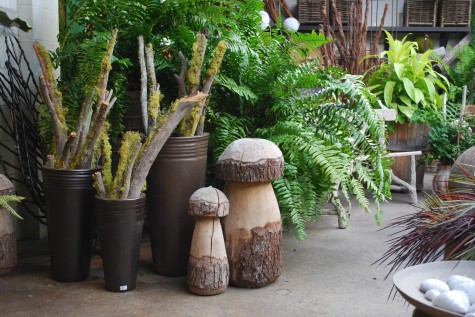 Once Rob gets a theme going, he has a sure hand putting a vignette together. The fern collection is kept company with lichen encrusted sticks from Oregon and carved wood mushrooms from Belgium. The giant fronds of what we call Macho ferns from his yard arch out some 30 inches, and cascade gracefully to the floor. We have turned on our heat, but an industrial building from the 1940’s heated with old Modine greenhouse furnaces stays decidedly cool.
Once Rob gets a theme going, he has a sure hand putting a vignette together. The fern collection is kept company with lichen encrusted sticks from Oregon and carved wood mushrooms from Belgium. The giant fronds of what we call Macho ferns from his yard arch out some 30 inches, and cascade gracefully to the floor. We have turned on our heat, but an industrial building from the 1940’s heated with old Modine greenhouse furnaces stays decidedly cool. A chartreuse dracaena named “Janet Craig” that grew vigorously over the summer in an oak barrel is brought inside. Its fountain like habit of growth is fern like, but the texture much more simple and dramatic. I find shade loving tropicals are indispensible for growing shade containers that are fresh and lively-different than the usual. This plant will winter well here; it will make a fine centerpiece for a shade pot next summer.
A chartreuse dracaena named “Janet Craig” that grew vigorously over the summer in an oak barrel is brought inside. Its fountain like habit of growth is fern like, but the texture much more simple and dramatic. I find shade loving tropicals are indispensible for growing shade containers that are fresh and lively-different than the usual. This plant will winter well here; it will make a fine centerpiece for a shade pot next summer.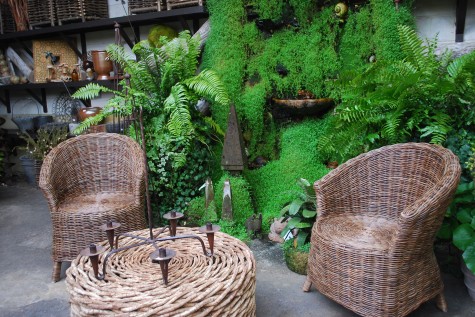 A pair of woven wood chairs and a table are drawn up to the fountain wall covered in baby tears. The elements of water and moss add to the woodsy look of a fern room. I cut a hole in the ceiling here large enough to handle the roof of an old Lord and Burham greenhouse. A shop devoted to all things garden would seem lacking without water, and a space to grow plants.
A pair of woven wood chairs and a table are drawn up to the fountain wall covered in baby tears. The elements of water and moss add to the woodsy look of a fern room. I cut a hole in the ceiling here large enough to handle the roof of an old Lord and Burham greenhouse. A shop devoted to all things garden would seem lacking without water, and a space to grow plants. As the room starts to fill up with plants, the space begins to feel like a conservatory. It is no wonder people go to great trouble and expense to have glass houses, or grow lights in the basement. I perfectly understand that feeling of being shut in, once I am shut out of the garden. These ferns make me think about having plants at home over the winter.
As the room starts to fill up with plants, the space begins to feel like a conservatory. It is no wonder people go to great trouble and expense to have glass houses, or grow lights in the basement. I perfectly understand that feeling of being shut in, once I am shut out of the garden. These ferns make me think about having plants at home over the winter. 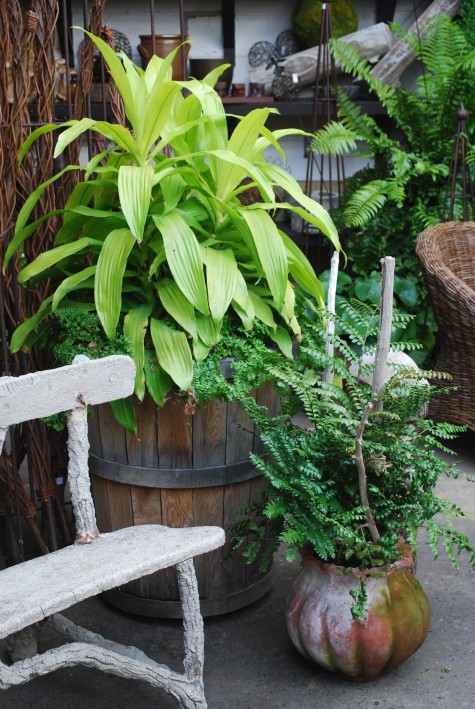
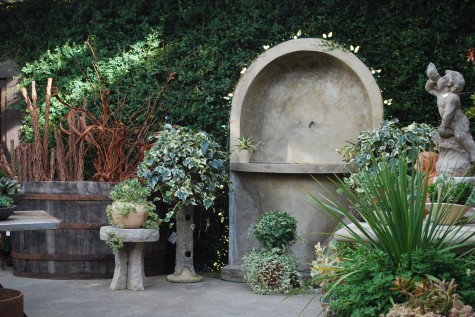 We find a home for the other bits as well. A pair of variegated Algerian ivies are so striking in a pair of old faux bois planters. A spike encircled with Cuban oregano organizes a collection of small agaves and echeverias; Rob is calling this the arid zone. An old varigated ivy single ball topiary in need of a haircut will get a winter home somewhere in this room. The climbing fig that covers the walls completes the green picture.
We find a home for the other bits as well. A pair of variegated Algerian ivies are so striking in a pair of old faux bois planters. A spike encircled with Cuban oregano organizes a collection of small agaves and echeverias; Rob is calling this the arid zone. An old varigated ivy single ball topiary in need of a haircut will get a winter home somewhere in this room. The climbing fig that covers the walls completes the green picture. 